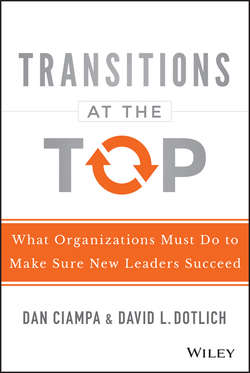Читать книгу Transitions at the Top - Ciampa Dan - Страница 7
Introduction
ОглавлениеThis is a book about transitions at the top of organizations. Like other books on this topic, it offers an answer to why the success rate is so low of those who have been hired or promoted into senior leadership positions and suggests ways to increase the probability of success. But, unlike others that have been published, this book deals with an aspect of transitions at the top that has been ignored. This will be, as far as we know, the first book to focus attention exclusively on the role of the organization and all of the key people involved with senior leader transitions, including the various individuals involved, systems, and processes. It delves deeply into what directors, the CEO, the head of human resources, and the other senior managers must do individually and collectively to best ensure the handoff from an incumbent leader to the one who will step in to replace her in a planned transition. In particular, it details:
● How the board should manage its accountability for overall continuity of leadership
● How the incumbent CEO should direct the entire sequence of activities that lead to a handoff of authority, ensure all pieces of the puzzle fit together, and ensure his successor has the best chance to succeed while handling the necessary task of his own exit
● How the chief human resources officer (CHRO) should coordinate the various steps of the search process and the transition process while also providing the staffing and counsel to the CEO necessary for a smooth, successful handoff, all while navigating the sometimes delicate position as the person in between the relationship of the CEO and board
● How senior managers who report to the CEO (and will to his successor), can best prepare themselves and prepare their divisions or functions for the changes that come from a transition at the top while also providing important help to the new leader
We combine more than 80 years of experience in working with and experiencing ourselves the planning and executing of senior-level transitions and the organizational changes they cause. We have seen firsthand the investment of effort, time, and money that companies make in searching for a new CEO, assessing candidates, debating choices, planning for various outcomes, making an offer, negotiating terms, and finally securing the commitment of a new leader. But, too often, once an offer is accepted, little else is done to ensure the investment in search and selection yields a return. Those involved believe the job is complete and return to their normal duties, leaving the new leader and the organization she has taken over on their own, unprepared to deal with the challenges of authority and organizational change that any transition brings. There has been little research and few books or articles about the steps that directors, CEOs, CHROs, and other stakeholders should take to ensure the new leader has the best chance of success. Most of what has been written has guided new leaders rather than the organizations they join. Dan co-authored a seminal book in this area (Right from the Start) and has advised on successful transitions since managing his own succession in the mid-1990s. He has the experience (rare in the advice business) of having been a designated successor, and then, after being chairman and CEO for a dozen years, hiring his successor and, over a planned 18-month transition, managing his own CEO handoff. David, a former CHRO of Honeywell, is now chairman and CEO of Pivot Leadership. He also works with boards and CEOs on talent and development strategies, including succession. Pivot Leadership works with companies around the world to execute strategy, become aligned, and adapt to change, including onboarding new leaders through executive development programs.
